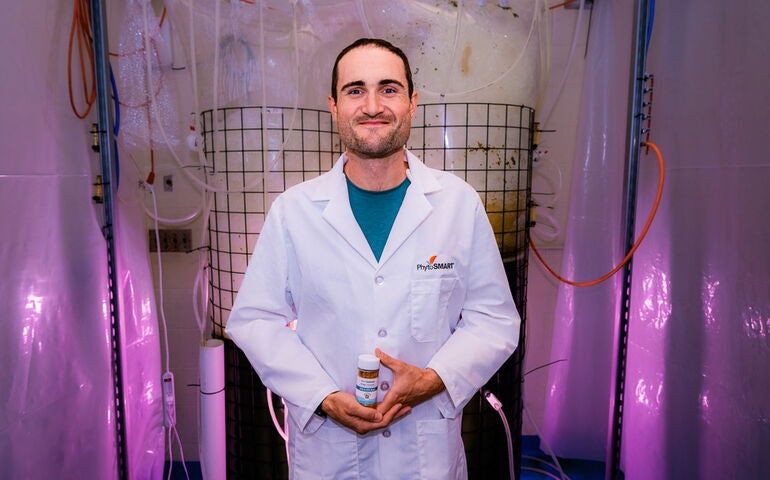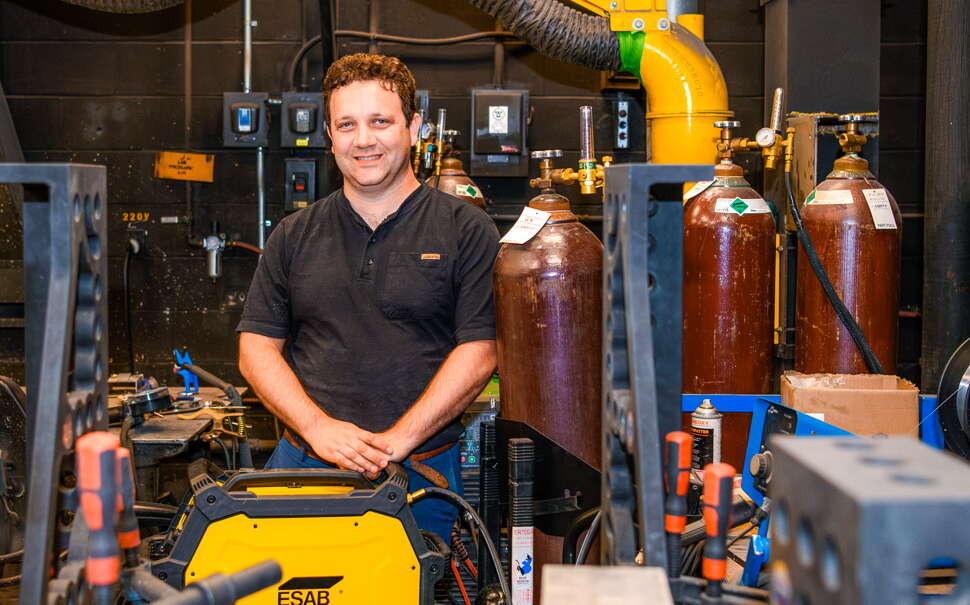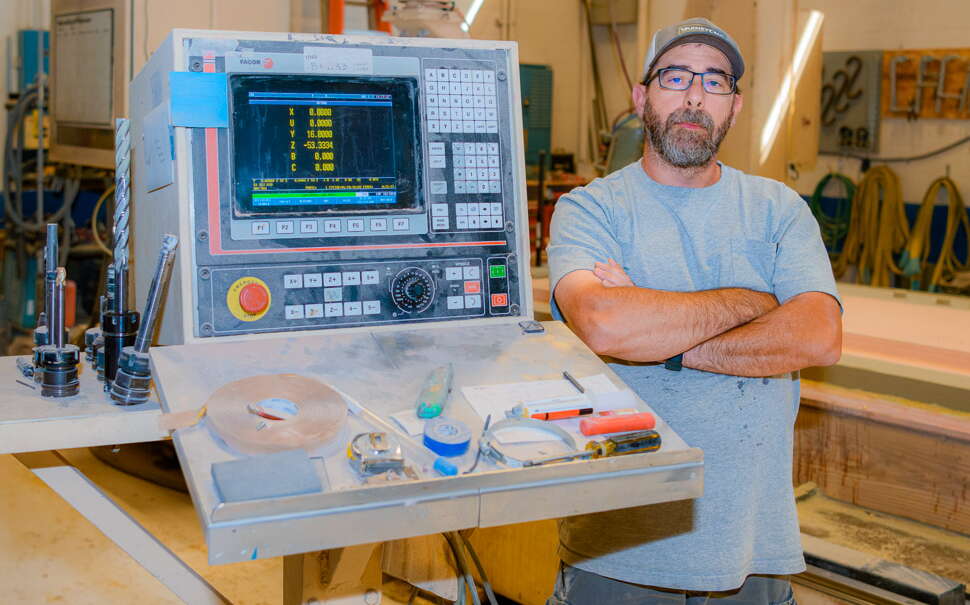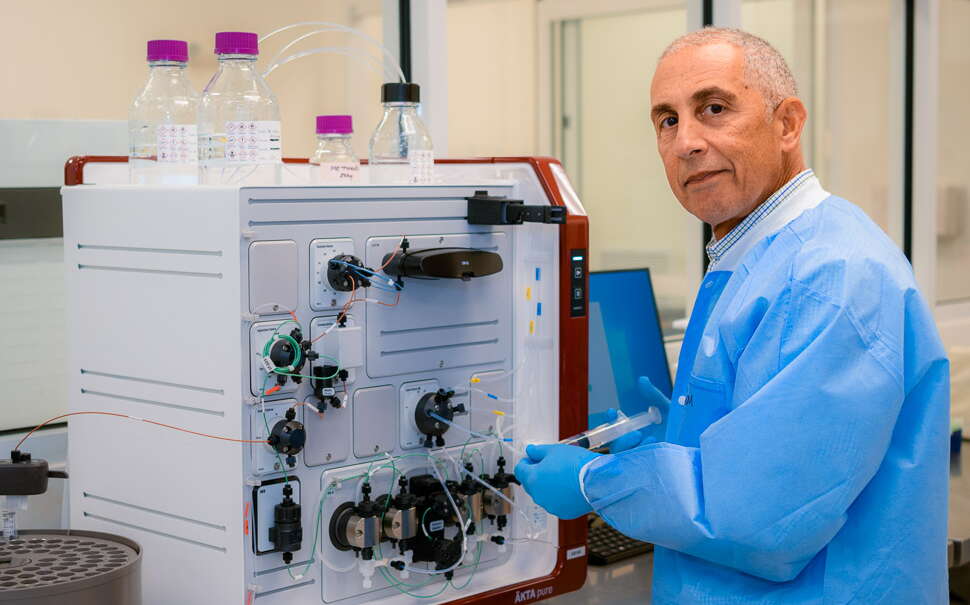
From the Cold War to high tech: Behind the scenes at TechPlace, Brunswick’s business incubator
 Photo / Jim Neuger
Patrick Cregten, operations director of PhytoSmart, in the company’s production facility in TechPlace in Brunswick.
Photo / Jim Neuger
Patrick Cregten, operations director of PhytoSmart, in the company’s production facility in TechPlace in Brunswick.
From the outside, the former Navy aircraft maintenance building isn’t much to look at — a drab relic of the 1940s when Brunswick Naval Air Station opened at a former municipal airfield.
More than a decade after the base was decommissioned in 2011, the Cold War vibe lingers inside long gray corridors that evoke military bureaucracy, a business suite furnished with a Navy-leftover brown leather sofa and chairs, and a windowless chamber once dubbed the “spooky room.”
Based on Maine’s southern midcoast, TechPlace is an incubator for early-stage manufacturing and technology startups. A world apart from Northeastern University’s modern Roux Institute in Portland, TechPlace is an equally important hub for entrepreneurs.
Adjacent to the Brunswick Landing business park, TechPlace is a maze of rented and shared offices, manufacturing workspaces, laboratories and storage areas used by dozens of early-stage manufacturers in sectors from aviation and aerospace to advanced materials and composites.

“You come into a former Navy facility. Then you open a door and there’s crazy innovation going on,” Jaimie Logan says during a three-hour tour of the 95,000-square-foot facility.
As director of TechPlace since 2022, the former maritime attorney and state official with Maine’s Department of Economic and Community Development is the self-proclaimed “den mother” of this unassuming innovation hub with an outsized impact.
“It’s not just a feeder for Brunswick,” she says as she dashes in and out of offices. “It’s a statewide asset.”
That asset has a big fan base among startup mentors across Maine.
“I often describe it as a launchpad for companies moving from concept to production,” says Susan Ruhlin, executive director of Dirigo Labs in Waterville.
Along similar lines, Eaton Peabody business consultant and Biddeford Mayor Marty Grohman says, “For a startup that’s got a prototype to test out and scale up, TechPlace is like a dream. All the tools, technology and people are right there. You can feel the energy.”
Longtime tenants include Greisen Aerospace LLC, whose President Daniel Greisen rented a desk shortly after TechPlace opened.
“It was pretty dead at the beginning, but it slowly grew and got more and more companies,” says Greisen, whose company now occupies more than 2,500 square feet and does contract work for the U.S. Defense Department.

As much as Greisen would love to stay put at TechPlace, he’s braced for the inevitability of moving as his company grows – even if that means giving up a shared paint booth and useful collaborations.
“On the manufacturing side,” he says, “we all help each other out.”
The same goes for VarneyCNC, a composites manufacturer whose projects include building a polyurethane foam swim platform for a powerboat.
“We’re a good example of how much stuff you can pack into 3,000 square feet,” says Nathan Varney, the company’s president. At TechPlace, “we all speak the same language.”
An incubator is born
The idea behind TechPlace was part of the original redevelopment plan for Brunswick Landing, according to Steve Levesque, the first executive director of the Midcoast Regional Redevelopment Authority until his retirement in late 2021.
“We had a lot of very big buildings on the campus, but we didn’t have anything that could accommodate a small business,” he recalls. Upon seeing the former aircraft maintenance building at 74 Orion St., “I said, ‘This would be a great small business incubator,’ because it’s already broken up into a lot of small spaces and small shops.”
With funding from a combination of sources, TechPlace opened in 2015. It’s owned and operated by the Midcoast Regional Redevelopment Authority, which also owns and operates the public portions of the adjacent Brunswick Landing.

As Brunswick Executive Airport deals with the aftermath of August’s accidental spill of toxic firefighting foam, and the MRRA seeks a successor to Kristine Logan who recently resigned as executive director, it’s business as usual for TechPlace’s 38 members. Together they employ 111 people.
Bubbling bioreactors
Inside the PhytoSmart lab, the sound of liquid bubbling inside sterile bioreactors behind a protective tent evokes a micro-brewery, minus the hoppy aroma.
But this isn’t beer being brewed, it’s micro-algae being processed into phytonutrients by operations director Patrick Cregten for use in superfoods for dogs and cats.
“We can find it [micro-algae] in any ocean in the world that I keep alive in the lab,” says Cregten, a marine biologist and aquaculturist from New Zealand.
Under a patented process, Cregten uses the bioreactors to spin the water out of the algae to turn it into powder. The powder is then dried to create Omega-3 essential fatty acids to keep pets healthy.
“There’s no other source I know of Omega-3 that is not either fish or ultra-processed,” explains Cregten, happy for some visitors on a day he’s working on his own.
“I don’t think we’d be able to exist anywhere else,” he says. “The capital costs in doing what we’re doing are outrageous, so to have a place that has almost all of what you need is fantastic.”
His take on TechPlace after working there for five years: “This is a wild mix of production and laboratory spaces that I don’t think you’d find in many places.”
Equally keen on the co-working setup, Cregten says, “It’s a community for sure — we all gossip around the water cooler.”
Biomedical innovator
Salmonics LLC is another life sciences startup with roots in TechPlace. The company, founded in 2020, turns fish-derived plasma proteins that would otherwise be discarded as waste into biomedical products for research and diagnostic purposes.
The company, whose investors include Norway’s Lerøy Seafood Group, is currently marketing seven products with another in development and working on a product for veterinary surgical use, to stop bleeding, reduce inflammation and provide pain relief.
In the early days of the pandemic, Cem Giray launched Salmonics in a space previously used by the Navy to paint finished airplane parts. Despite investing heavily to adapt the space, Giray says the reasonable rent was a big plus for a new business with limited financial resources.
“It was the perfect setup in terms of support, infrastructure and networking and other support,” he says. “It works really well for a startup.”
Today with a team of six employees and eight contractors, Salmonics rents around 2,400 square feet of laboratory, manufacturing and storage space at TechPlace, frequently collaborating with other members.
Harbor Digital, for example, supplies Salmonics’ information technology system, while Greisen Aerospace has been using its engineering and 3D-printing capabilities to develop a blood-collection apparatus for Salmonics.
“Even companies outside of TechPlace have provided some support as well,” Giray says. “It’s really nice to have that Brunswick Landing network.”

About about a third of the way toward a $2 million fundraising goal, Salmonics plans to stay put at TechPlace for the foreseeable future.
“We can produce 20, maybe 25, times what we produce currently within the same footprint,” Giray says. “We can certainly add on people and more production.”
Alumni in the neighborhood
STARC Systems, a maker of clean modular barriers used during renovations, was TechPlace’s first industrial tenant, occupying around 4,500 square feet in the machine shop area. Previously, it was based in a 2,500-square-foot space about 75 miles up the coast in Cushing.
“We quickly outgrew that and needed room to build our product,” says Bruce Bickford, the first employee hired by the company’s founder, Tim Hebert, in early 2014.
TechPlace “was our first opportunity to have a large space to ourselves,” he recalls. “There was no commercial real estate of that size that had enough room and an overhead door at a reasonable price. It was a tremendous opportunity to help us get launched.”
After leaving TechPlace in September 2017, the company went to Brunswick Landing, where it has continued to grow. Today on the Landing, its 103 employees spread across three locations.
The company, led by President and CEO Chris Vickers, is majority-owned by North Branch Capital, a private equity firm based in Oak Brook, Ill., via a buyout in September 2023. At the time, there was also significant reinvestment by Hebert, who was recognized as a Mainebiz Business Leader of the Year in 2020.
North Branch bought a stake from Richmond, Va.-based Blue Heron Capital, which invested $3.5 million in STARC Systems in 2017.
STARC Systems will continue its next chapter in a new 85,000-square-foot manufacturing and administrative facility near Hangar 6 at Brunswick Landing. STARC Systems will lease the facility from Priority Real Estate Group, of Topsham.
Currently in final permitting, the project will break ground this fall, according to Bickford, who says the company is keen to keep its employee base in Brunswick.
“Going somewhere else is disruptive,” he says. “We enjoy the amenities of the Landing, and some flexibility in terms of how we can occupy new spaces.”
Similar to STARC, bluShift Aerospace is another TechPlace graduate now based at Brunswick Landing, where the company occupies around 12,000 square feet of manufacturing and office space along with a rocket-launch test site. The 12-employee company plans to keep hiring.
“Brunswick is a great place for us to attract talent, and our plans are to keep that as our R&D and headquarters location,” says Sascha Deri, bluShift’s founder and CEO. Decades ago when he was in high school, he used to drive past the Brunswick Naval Air Base when it was was off limits to the public and glimpse planes flying overhead.
While TechPlace had not yet opened when he founded bluShift in Massachusetts in 2014, the attractive location and funding from Maine Technology Institute “made it very easy to jump to Maine” in 2016, he says.
His first impression of TechPlace: “Awe and excitement, starting aerospace here among tech entrepreneurs in a place of such rich aviation heritage,” he says.
Charting a new course
Today, there isn’t much room for companies that outgrow TechPlace but want to stay in the neighborhood. That’s because Brunswick Landing is about 97% full, according to Jake Levesque, MRRA’s director of innovation and development since August 2023.
With plenty of options elsewhere on the site, the agency aims to create a second startup hub, for companies that are beginning to scale up.
“We’re in the process of discussing options with developers to create a TechPlace 2.0 or TechPlace Grad School,” Levesque explains.
Location options include 11 lots currently for sale of varying sizes. Though pretty scattered, five are grouped together near Hangar 5. Levesque reports that handful of developers are interested in building on the lots, undeterred by the aftermath of this summer’s toxic chemical spill.
“There is a lot of negative talk happening right now, but our development efforts are about five years ahead of schedule,” he says.
Meanwhile at the current TechPlace, Josh Hardy helps out wherever he can, months after his former employer — aquaculture startup Running Tide — closed down and cleared out.
“I’ve been approached by a few business owners to come and work for them, but I’m trying to take it slow and figure out what makes sense for me,” he says. At TechPlace, he’s perfectly placed to do that.













0 Comments